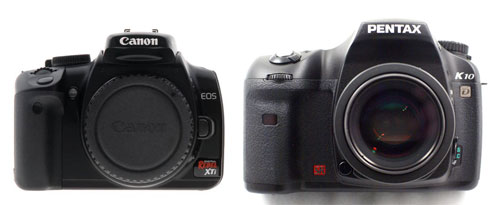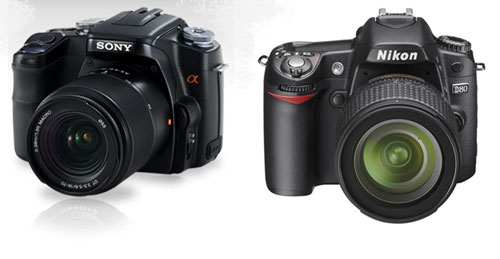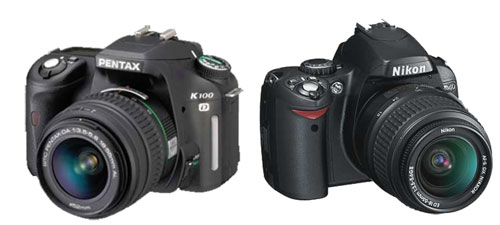As a result of the recent rush to 10 megapixel digital SLR cameras, everything that has been held sacred in the camera business is now upside down. At the price of yesterday's 6 megapixel cameras you can now buy almost twice the resolution - and you can definitely see the difference in pictures taken at 6 and 10 megapixels. The $1700 Nikon D200 is now mostly the same feature set and virtually the same 10 megapixel sensor as the new $999 Nikon D80, and the $800 Canon Rebel XTi has almost the same processing engine as the $1500 Canon 30D and a 10 megapixel resolution compared to the 8 megapixel of the 30D. Since so much has progressed so fast in the last few months, it is time for a hard look at what is available in the hottest digital camera segment - digital SLRs.
The new "entry" level digital SLR market, generally defined as digital SLR cameras that sell for $1000 or less, has certainly expanded at both the bottom and the top. Today you can actually buy a digital SLR camera in the $400 to $500 price range, which was unheard of as recently as last year's Holiday buying season. This lower entry price has practically made the popular fixed lens SLR and "quality" pocket digital cameras all but obsolete. Why pay $800 for a fixed lens digital when you can get more features and flexibility with an interchangeable lens digital SLR at a lower price? This "prosumer" category of the past is rapidly disappearing, but it is worth pointing out that there is always room for a high-quality, pocketable fixed-lens digital camera.


The $1000 and under segment, which used to be entry level SLR cameras, now includes10 megapixel models at the top, and the feature sets for this new generation include enhancements previously available only on much more expensive cameras. All of the 10 megapixel SLRs are faster than their predecessors - borrowing processing engines from higher priced models (Nikon and Canon) or pioneering new high-speed processing circuits (Pentax and Sony).

The "entry" market is now segmented into true entry level SLR cameras in the $400 to $600 price range, the new 10 megapixel mid-range SLRs at $700 to $1000, and a couple of mid-range 8 megapixel SLRs that straddle the middle in the $600 to $700 range. In practical terms it is very difficult to tell any difference between 6 and 8 megapixel images, or between 8 megapixel and 10. However, there is a discernable improvement in moving from 6 to 10 megapixels.
This SLR Buyer's Guide will take a closer look at the top of this range, comparing the new 10 megapixel models. We will also compare models in the true entry level $400 to $600 range. The 8 megapixel models will be considered at both ends of the spectrum for features and value. Prices quoted in this guide are based on the best prices we could find at major online retailers like Newegg or Amazon. These are also typical prices in our own price engine. The prices quoted should be available to any online shopper, but you may find even better prices if you are willing to do more searching. Conversely, local photo specialty retailers normally provide better customer support and return options than etailers, and their prices for the same item will generally be higher.
If you are shopping for a digital camera but you're not really a photo hobbyist, you might want to start with our overview of digital photography in Digital Photography from 20,000 Feet. In that introduction we cover the terms and concepts used in this Buyer's Guide. If you're a photo hobbyist then dive in. Our advice is not jaded, and many will be surprised that Nikon and Canon were not our first choices in every category. 2006 was definitely the year of the Digital SLR camera, and the names that are new or that resurfaced this year are definitely making shopping for a new Digital SLR more fun than it has been in a very long time.
The new "entry" level digital SLR market, generally defined as digital SLR cameras that sell for $1000 or less, has certainly expanded at both the bottom and the top. Today you can actually buy a digital SLR camera in the $400 to $500 price range, which was unheard of as recently as last year's Holiday buying season. This lower entry price has practically made the popular fixed lens SLR and "quality" pocket digital cameras all but obsolete. Why pay $800 for a fixed lens digital when you can get more features and flexibility with an interchangeable lens digital SLR at a lower price? This "prosumer" category of the past is rapidly disappearing, but it is worth pointing out that there is always room for a high-quality, pocketable fixed-lens digital camera.


The $1000 and under segment, which used to be entry level SLR cameras, now includes10 megapixel models at the top, and the feature sets for this new generation include enhancements previously available only on much more expensive cameras. All of the 10 megapixel SLRs are faster than their predecessors - borrowing processing engines from higher priced models (Nikon and Canon) or pioneering new high-speed processing circuits (Pentax and Sony).

The "entry" market is now segmented into true entry level SLR cameras in the $400 to $600 price range, the new 10 megapixel mid-range SLRs at $700 to $1000, and a couple of mid-range 8 megapixel SLRs that straddle the middle in the $600 to $700 range. In practical terms it is very difficult to tell any difference between 6 and 8 megapixel images, or between 8 megapixel and 10. However, there is a discernable improvement in moving from 6 to 10 megapixels.
This SLR Buyer's Guide will take a closer look at the top of this range, comparing the new 10 megapixel models. We will also compare models in the true entry level $400 to $600 range. The 8 megapixel models will be considered at both ends of the spectrum for features and value. Prices quoted in this guide are based on the best prices we could find at major online retailers like Newegg or Amazon. These are also typical prices in our own price engine. The prices quoted should be available to any online shopper, but you may find even better prices if you are willing to do more searching. Conversely, local photo specialty retailers normally provide better customer support and return options than etailers, and their prices for the same item will generally be higher.
If you are shopping for a digital camera but you're not really a photo hobbyist, you might want to start with our overview of digital photography in Digital Photography from 20,000 Feet. In that introduction we cover the terms and concepts used in this Buyer's Guide. If you're a photo hobbyist then dive in. Our advice is not jaded, and many will be surprised that Nikon and Canon were not our first choices in every category. 2006 was definitely the year of the Digital SLR camera, and the names that are new or that resurfaced this year are definitely making shopping for a new Digital SLR more fun than it has been in a very long time.










89 Comments
View All Comments
finbarqs - Tuesday, December 26, 2006 - link
I like the XTi's ergonomics, but i guess different strokes for different folks. I do like the fact that Pentax actually feels of high quality, and the biggest problem the XTi is the "cheap" plastic build quality... But i do love their CMOS technology and their noise reduction method!Justin Case - Tuesday, December 26, 2006 - link
Yes, Canon still has the best sensors (and best telephoto lenses - /me hugs his 70-200 2.8 IS), although Nikon as virtually caught up with the D2X and D200 (and they have the best wide-angle lenses, although Canon's 18-55 2.8 IS EF-S is bloody amazing).The XT / XTi is fine if you have small hands, but my big paws will almost cover the lens when I grab one. I hope they release a new model soon, with the 30D / 1D / 5D body and the XTi's improvements.
noxipoo - Wednesday, December 27, 2006 - link
*DROOL* 70-200 2.8 IS, i'm thinking about the 70-200 2.8L, can barely afford that one... anyway, have your tried the XTi with the battery grip? XTi is a good size to me, but bigger wouldn't hurt either.Justin Case - Wednesday, December 27, 2006 - link
Speaking of battery grip, that's another thing that annoyed me about the XT (and XTi) - they halved the battery's capacity. Sure, now they can say it's lighter (than the original DRebel), but you have to carry twice as many batteries! Duh. I haven't tried it with the grip, but it feels like a hack. I'd rather wait for the 40D (or whatever the successor to the 30D will be called).The 70-200 2.8L is great. The non-IS model should be just as good, optically, and a bit smaller and lighter (and cheaper, of course). I bit the bullet and got mine after playing with some similar lenses from other brands, but this one is on a different league. It's actually sharper than some primes on the same range.
Right now I'm pondering on whether to trade my next vacation for an EF-S 18-55 2.8L IS (I've used one briefly, and it's amazing). It's probably the best autofocus lens in that range from _any_ manufacturer. Of course, that would sort of "lock me" into the 1.6x sensors, but that might not be such a bad thing, if future EF-S lenses are going to be this good.
Justin Case - Tuesday, January 2, 2007 - link
Correction: I mean EF-S 17-55 2.8 IS, of course. The EF-S 18-55 is not f/2.8.noxipoo - Wednesday, December 27, 2006 - link
has canon said how long they are committed to the EF-S mount? last i heard canon hasn't said a thing.noxipoo - Tuesday, December 26, 2006 - link
the canon cameras will outsell everyone else by a lot i think, as usual.yyrkoon - Tuesday, December 26, 2006 - link
I'd like to point out for those who don't know already, and perhaps you "guys" could include it in your articles, or future articles. There are Web sites out there, that sell Cameras at unheard of prices. For instance, when I was pricing the Nikon D80 about 3 months ago, everyone, except on site was selling them at comparable prices. This one web site was selling them MUCH lower than the rest, and there was a good reason. These web sites (some argue are all owned by the same company, just different sites) are rip offs. They mark the camera down, take things like battery packs, warranty, lenses etc out of the kit, and claim, so basically, all you're buying is the camera, and then try to charge you, the customer unheard of prices for these things that are supposed to be sold in the kit. Not only this, these web sites sell cameras, that were originally supposed to be sold in other countries . . .Anyhow, if the price is too good, it is, don't fall for the trap. If in doubt, search the web site in question on resellerreviews.com or some such site. Also, I'm not sure why, but google allows these people to advertise with them, and thus, they will likely show at the top of any google search, under featured advertisers . . .
Luckily, being the cautious person I am, I never got duped, but there are MANY people who have been . . .
Wesley Fink - Tuesday, December 26, 2006 - link
We have seen the same things in online shopping for cameras. It is a common tactic among unscrupulous sellers who always seem to be located in New York City. That does not mean all NY camera sellers are bad, because there are a number of excellent sellers in the city like B&H. If it seems way too good to be true it probably is.What you describe is the reason we mentioned in the guide that our prices came from large well-known etailers like Amazon and Newegg. The Amazon price on the entry Pentax K110D kit is currently $452 (or $402 for body only) with a $50 Pentax rebate reducing the price further.